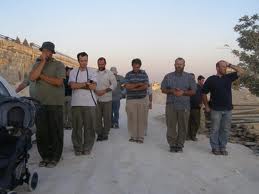Minha Service
The Minha service is held at twilight and is one of the three daily services of the Jewish liturgy. It is commonly thought that the term Minha came from Kings 1 18:36 where it is written that Elijah prayed during the time of the Minha, a sacrifice of grains (wheat and barley, rather than animal).
It is traditionally believed that the reason for having three daily prayers symbolizes the three patriarchs, Abraham, Isaac, and Jacob. This can be found in the Talmudic text of Masekhet Brakhot, 24, page 2, from the line “tfilot avot tiknum” and so on. Traditionally it is thought that it was Issac who initiated the Minha service. This belief is based on Genesis 24:63 where it is written, “He went out to the field one evening to meditate.” In the original Hebrew, the word used instead of meditate is “lasuah,” which translates to “converse” and is commonly interpreted as prayer. Additionally, the Minha service is associated with the “Tamid” sacrifice that was sacrificed at twilight in the Temple in Jerusalem.
The importance of the Minha can be found again in the Talmudic text of Masekhet Brakhot 6 , p B:“R. Helbo further said in the name of R. Huna: A man should always take special care about the afternoon-prayer. For even Elijah was favourably heard only while offering his afternoon-prayer.”
The Talmud refers here to the story from Kings 1 18:26 where Elijah confronts the prophets of Baal on Mount Carmel. There, he prayed to God during the time of the Minha sacrifice and his prayers were immediately answered. The Talmud incurs from this that prayers are more likely to be answered during that time of the day. The rabbis, therefore, warned people to take special care during this service, lest they miss the advantage of the service's hour in order to have their prayers fulfilled.
The Minha service is additionally unique in that it is recited in the middle of the day, therefore interrupting the flow of the day (in contrast to the Shaharit and 'Arvit prayers that begin and end the day, respectively).
The Minha service includes:
*The 'Korbanot' – selections from the bible and the Mishna that describe the day-to-day work of the Temple.
*“Ashrei yoshvei beitekha, 'Od yehalelukha selah” - a chapter from Psalm 145.
*The 'Amida prayer - recited silently while facing Jerusalem
* Tahanun – confessional segments and atonement for transgressions.
* 'Aleinu leshabeah - prayer that includes a segment that expresses gratitude for being given the opportunity to worship God.
There are two types of Minha services:
1. The Minha G’dola (large Minha) – recited in the afternoon hours—that is, after six and a half temporal hours.[1] It is called the large Minha because the day is still at large when it is over.
2. The Minha K’tana (small Minha) – recited towards sundown, after nine and a half temporal hours. According to the Shulhan 'Arukh, the small Minha is preferable. Sundown marks the end of the Minha and it closes the twelve temporal hours of the day. Since the Jews of 19th century Ashkenaz were usually under pressure from the daily toils of their lives, it was difficult for them to make it to the synagogue for both Minha and 'Arvit. Therefore, they used to say the Minha adjacent to sundown, so that they would only need a short break before continuing directly into 'Arvit.
Before Ashrei Yosvhei Beitekha
Sephardic and Italian communities, as well as most Yemenite communities, customarily recite Psalm 84 before “Ashrei Yoshvei Beitekha,” followed by the Korbanot and Pitum HaKtoret sections. Some of the Sephardic communities customarily recite part of the introduction to theTikunei HaZohar, followed by the kaddish, before reciting Psalm 84. Some of the western European Sephardic communities excluded the Pitum HaKtoret section. According to Sephardic nusah , Parashat HaKiyor, Parashat HaKorbanot, Pitum Ktoret, and Ana BeKoah are recited before the Ashrei.
Many Ashkenazi and some Yemenite Jews do not add any prayers before Minha—they rather begin directly with Ashrei.
After “Ashrei Yoshvei Betekha”
After the recitation of Ashrei, the Sephardic communities recite the verse that begins “Tikhon Tefilati” and occasionally, the verse that begins “Hekshiva Lakol Shavi'i.”
After the Shmona 'Esre Prayer
In many Jewish communities, especially those in Israel, it is customary for the congregation to recite the Amida prayer silently and then for the cantor to repeat it out loud (Hazarat Hashatz). However, in some communities, the cantor does not recite the entire Shmona 'Esre out loud; rather, he recites the first three blessings of the Shmona 'Esre immediately after the Kaddish (including the Keddusha) and the rest of the prayer is recited silently. This custom can be found in the Lithuanian Yeshivas who believe that extended prayers keep students from the important work of Talmud study. In still other communities, such as the western European Sephardim, the cantor chants the last three prayers of the Hazarat Hashatz. In Yemenite communities, however, the prayer leader chants all of the blessings out loud.
[1] Temporal hours are a relative unit of time based on the season where the daylight hours and night time hours are each split into 12 equal groups.




